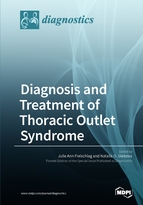Diagnosis and Treatment of Thoracic Outlet Syndrome
A special issue of Diagnostics (ISSN 2075-4418).
Deadline for manuscript submissions: closed (30 November 2017) | Viewed by 121198
Special Issue Editors
Interests: treatment of thoracic outlet syndrome
Special Issues, Collections and Topics in MDPI journals
Special Issue Information
Dear Colleagues,
Thoracic outlet syndrome (TOS) is a spectrum of disorders resulting from the compression of the neurovascular structures within the thoracic outlet. The three main subtypes of TOS are defined by the anatomic structure affected by the extrinsic compression. In the most common subtype—neurogenic TOS—the brachial plexus is compressed and symptoms include pain, arm paresthesias, and sometimes weakness. Venous TOS is characterized by the compression of the subclavian vein and its resultant thrombosis. Arterial TOS is the least common and is distinguished by the compression of the subclavian artery and development of aneurysms or stenoses with distal embolization. Treatment options include physical therapy and surgical first rib resection via the transaxillary or supraclavicular approach. Diagnosis of TOS and appropriate patient selection for intervention are challenging due to the frequent presence of vague symptoms in neurogenic TOS. Due to the relative rarity of this condition, different approaches to diagnosis and management exist, and optimum management strategies continue to evolve.
The primary goals of this Special Issue on “Diagnosis and Treatment of Thoracic Outlet Syndrome” are to describe new and established diagnostic and treatment modalities for TOS; to discuss approaches to complex clinical situations, such as reoperative treatment; and to review new research developments in the field of TOS.
Prof. Dr. Julie Ann Freischlag
Dr. Natalia O. Glebova
Guest Editor
Manuscript Submission Information
Manuscripts should be submitted online at www.mdpi.com by registering and logging in to this website. Once you are registered, click here to go to the submission form. Manuscripts can be submitted until the deadline. All submissions that pass pre-check are peer-reviewed. Accepted papers will be published continuously in the journal (as soon as accepted) and will be listed together on the special issue website. Research articles, review articles as well as short communications are invited. For planned papers, a title and short abstract (about 100 words) can be sent to the Editorial Office for announcement on this website.
Submitted manuscripts should not have been published previously, nor be under consideration for publication elsewhere (except conference proceedings papers). All manuscripts are thoroughly refereed through a single-blind peer-review process. A guide for authors and other relevant information for submission of manuscripts is available on the Instructions for Authors page. Diagnostics is an international peer-reviewed open access semimonthly journal published by MDPI.
Please visit the Instructions for Authors page before submitting a manuscript. The Article Processing Charge (APC) for publication in this open access journal is 2600 CHF (Swiss Francs). Submitted papers should be well formatted and use good English. Authors may use MDPI's English editing service prior to publication or during author revisions.
Keywords
thoracic outlet syndrome
neurogenic TOS
venous TOS
arterial TOS
transaxillary first rib resection
supraclavicular resection







